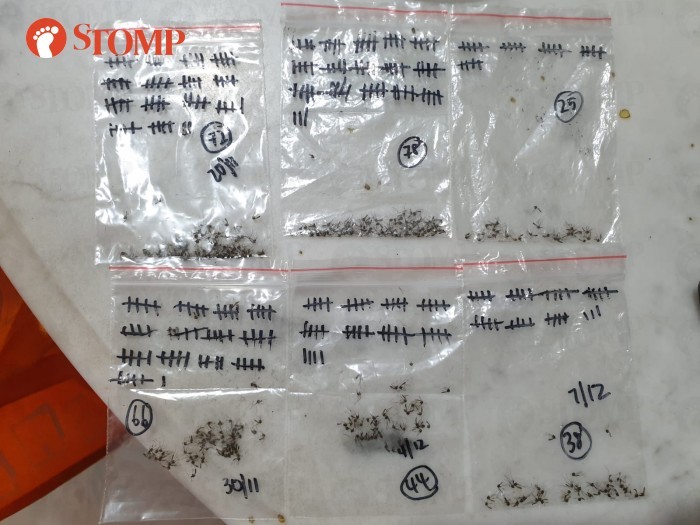There’s a mosquito serial killer on the loose.
And when I say on the loose, I really mean in one Tampines flat, because this mosquito murderer operates in her own house.
The woman told Stomp that she caught and killed 323 mosquitoes in just a month, and even kept their carcasses in Ziploc bags.

Now, if a friend came up to you and said they killed over 300 mosquitoes and kept their dead bodies in Ziploc bags, you’d probably back away slowly and question your friendship.
But this woman had a good reason to do so.
Buzzing Irritants
After moving back to her mother’s flat at Block 509 Tampines Central 1 in October, the woman discovered that large swarms of mosquitoes live in the same block.
“I am desperate to get rid of these mosquitoes. This living condition is affecting my family’s quality of life and it’s not conducive for us to work from home,” she told Stomp.
“We do get bitten by the mosquitos but not all the time, because we do hourly wipeouts with our three electric swatters to kill them.

“But even if they don’t bite us, it is still very itchy when they’re just flying around our legs.”
In just one week in November, the woman and her family caught and killed 103 mosquitoes.
Sounds fine, right? She has a mosquito problem and she’s solving it on her own.
The only problem is that the hundreds of mosquitoes she’s exterminating could be deliberately brought in to decrease the Aedes mosquito population.
Insects Killed Were Likely Male Wolbachia-infected Mosquitoes
Speaking to Mothership, the National Environmental Agency (NEA) revealed that the large swarm of insects were probably male Wolbachia-infected mosquitoes.
Wolbachia are extremely common bacteria that occur naturally in 60% of insect species and pose no risk to humans or the environment.
When male Wolbachia Aedes mosquitoes mate wit↨h female Aedes mosquitoes that do not carry Wolbachia, their resulting eggs do not hatch.
Over time, this will lead to a decline in the Aedes population.
These Wolbachia mosquitoes were first released in Tampines East Constituency in Feb 2020, and have gradually reduced the Aedes mosquito population.
In the area where the woman lives, the number of female Aedes mosquitoes caught in every 10 Gravitraps per week has halved.
Still, two dengue cases in the area were reported recently. This is why NEA will be releasing even more Wolbachia mosquitoes, as they aim to suppress the Aedes population by 90%.
NEA Officers Inspected Woman’s Home
NEA officers have since inspected the woman’s home in Tampines and advised her to use insecticide to kill any adult mosquitoes she encounters.
The agency explained to the woman that male mosquitoes sometimes swarm in one area, which is why the woman found such a large group buzzing in one spot.
NEA said it will obtain mosquito samples with the woman’s help to assist with their investigations.
They will also work with the Tampines Town Council over the feedback about the tree in front of her home.
“We understand the inconvenience experienced by some residents in Project Wolbachia areas,” the agency said.
To prevent this from happening again, NEA said it would adjust the distribution of the Wolbachia mosquito release.
You Might See More Mosquitoes on Mon & Fri Mornings
According to the NEA, these male Wolbachia mosquitoes are released on Monday and Friday mornings, meaning you might see more of them at these times.
NEA reminded residents that community vigilance and action remain critical in our fight against dengue.
Doing the Mozzie Wipeout can help prevent mosquitoes from breeding in your home.
Featured Image: Stomp & Google Maps




